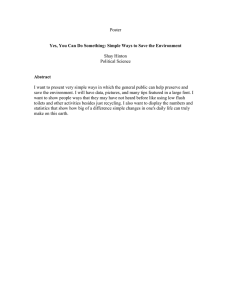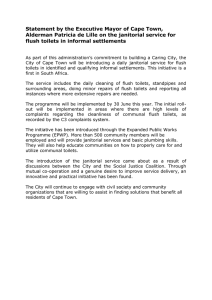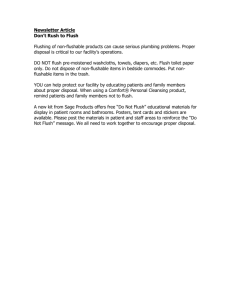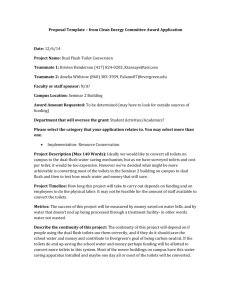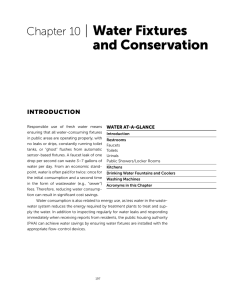Water Conservation Information - North Carolina Prototype School
advertisement
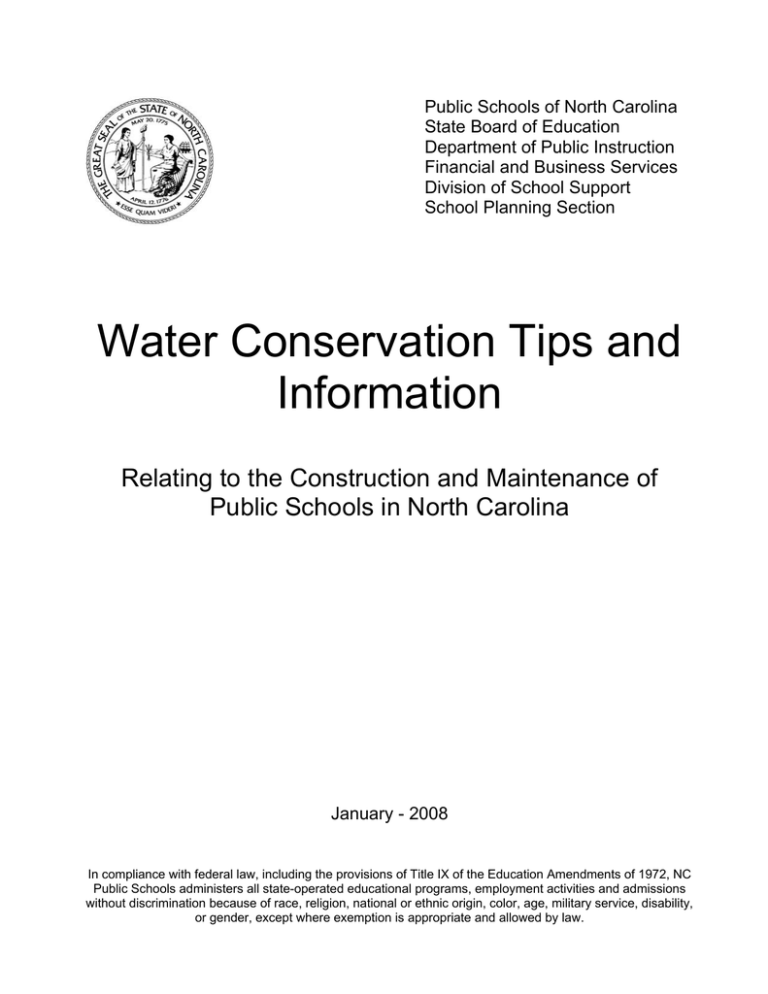
Public Schools of North Carolina State Board of Education Department of Public Instruction Financial and Business Services Division of School Support School Planning Section Water Conservation Tips and Information Relating to the Construction and Maintenance of Public Schools in North Carolina January - 2008 In compliance with federal law, including the provisions of Title IX of the Education Amendments of 1972, NC Public Schools administers all state-operated educational programs, employment activities and admissions without discrimination because of race, religion, national or ethnic origin, color, age, military service, disability, or gender, except where exemption is appropriate and allowed by law. Water Conservation Tips and Information During one of the most severe droughts in North Carolina history, it is important that we all do our part to help conserve our water supply. Not only is it important to conserve our accessible water supply, but also to implement new practices of water use and reuse. Schools play a vital role in water conservation due to the large number of students and faculty that occupy each facility. For example, during a normal school day at an average size middle school, 6,000 gallons of water will be used to flush toilets. The installation of certain water conservation devices, a rainwater harvesting system, and artificial turf on athletic fields are a few suggestions to help water conservation in North Carolina schools statewide. Presently, our new schools incorporate water saving devices and techniques into their facilities. The most common features include low volume flush valves on toilets, automatic flush valves for urinals, waterless urinals, and motion sensor faucets. During renovations and new addition projects at older schools, converting toilets from standard to low volume flush (about 1.5 gallons per flush) is a priority. In addition, waterless urinals are also being installed and experimented with in some LEAs. The biggest reason for not converting standard bathroom fixtures to more efficient fixtures is a lack of funds. Each automatic flush valve costs $200, while a motion sensor faucet costs approximately $175, not including the cost of labor. However, some LEAs already have a water conservation program in place. These LEAs have converted most of their bathroom fixtures and are currently in the process of converting all fixtures. Perhaps the easiest device to install and the least expensive is the low-flow aerator, each one costing $5-$10 depending on size and location. Likewise, motion sensor faucets can be installed to save water because their automatic shutoff allows water use only when necessary. Currently, toilets use the same amount of water whether it is liquid or solid waste. Dual flush toilets allow the option to lift up the handle to flush liquid waste or push down for a normal flush containing solid waste, saving approximately 30 percent of water used in a normal flush (when used properly). These toilets range from $250$300. For kitchen areas: • Replace standard pre-rinse sprayers with low-flow pre-rinse sprayers • Sweep floors and walkways instead of spraying if sanitation permits • Change from reusable plates and utensils to disposable Standard pre-rinse sprayers use approximately two to six gallons of water per minute, while the newly designed sprayers use slightly more than one gallon per minute. The cost of low flow sprayers ranges from $100-$150. The fixtures mentioned above save small amounts of water each use but throughout the course of a school year, the savings are tremendous. 1 Cost and water consumption comparison between standard and conservation devices Item Toilets Cost $100 Faucets $30 Pre-rinse sprayers $120 Standard Water use 3.5 gpf Conservative Cost Water use $200 1.6 gpf Differences Cost Water use +$100 -1.9 gpf 4.0 gpm $175 2.4 gpm +$145 -1.6 gpm 4.0 gpm $125 1.2 gpm +$5 -2.8 gpm (gpf – gallons per flush; gpm – gallons per minute) For other areas: • Installation of rainwater harvesting system • Replacing real turf with artificial turf on athletic fields • Monthly monitoring water usage for large increases which may be an indication of a leak in the piping Another new approach to conserving water is rainwater harvesting. This process involves collecting rainwater off roofs of schools and storing it in an underground cistern, thus allowing collected water to be used for flushing toilets. The flushed water then travels through an organic treatment system, and eventually can be used to irrigate athletic playing fields or other areas. With the rainwater harvesting system, the purchase of water will drastically decline, and the water supply previously used to flush toilets will be saved. The best example of the complete rainwater catching system can be observed at Northern Guilford Middle School by way of a system diagram found at the following website: www.gcsnc.com. The most significant cost in this system is the purchase of the cistern and pumps. The estimated system cost for an average size middle school for the first year is around $160,000 and will have a return on investment in 15 years 1 . Likewise, environmental benefits are a byproduct of rainwater harvesting. For example, less energy will be required to treat and transport water, and because rainwater is collected and not running off into streams there will be less local flooding and erosion of streams. Another benefit to implementing this process is the possibility of an excellent learning experience for the students. They will learn the importance of water conservation and will be more aware of the environment that surrounds them. Last, the maintenance of athletic fields at middle and high schools require substantial amounts of water. The drought that we are currently facing has forced us to look at alternative ways to maintain the health of the fields. The most drastic approach to conserving water would be to install artificial turf, which may prove to be the most costly; however, over time will pay dividends. Some of the benefits would be the cost savings associated with less use of the lawn equipment and less maintenance hours associated with keeping a playing field ready for competition. Another advantage is the increased amount of contact hours for artificial turf compared to natural grass. Natural grass requires a certain amount of breathing time while artificial turf can be used for long periods of time with no damage. Charlotte-Mecklenburg Schools is one LEA that has taken this route. The estimated cost for artificial turf for a football/soccer field is approximately $750,000 which includes the entire area inside of the track at a football/soccer stadium 2 . This cost covers 64,000 sq. ft. at $11.70/sq. ft. They expect to 1 2 Sample Middle School cost estimate found at www.innovativedesign.net Estimate provided by Tony Ansaldo of Charlotte-Mecklenburg Schools 2 replace the turf every 10 to 15 years at an estimated cost of $500,000, not including inflation. In December of 2007, the State Energy Office and the Division of Pollution Prevention and Environmental Assistance organized a Strategic Water Technology Conference in order to share information on water conservation. The presentations from that conference can be found at www.energync.net/waterworkshop/index.html. Additional information regarding water conservation can be found at www.ncwater.org “Guidelines Regarding Water Restrictions and Athletic Field Maintenance” can be found on the School Planning Section’s website www.schoolclearinghouse.org, Publications and Guides, then Other Entities. 3 Acknowledgments The Department of Public Instruction gratefully acknowledges the contributions of the following, without which the development of this publication would have been difficult. Daniel Boyette, Primary Author, Statistical Research Assistant, School Planning Section, NC Department of Public Instruction, Raleigh, NC Tony Ansaldo, Staff Architect, Charlotte-Mecklenburg Schools, Charlotte, NC Donald Hawks, Maintenance Director, Yadkin County Schools, Yadkinville, NC Allen Kerns, Energy Management, Randolph County Schools, Asheboro, NC Larry King, Director of Environmental Services, Person County Schools, Roxboro, NC Sidney Moody, Maintenance Supervisor, Granville County Schools, Oxford, NC Steve Taynton, AIA, Chief, School Planning Section, NC Department of Public Instruction, Raleigh, NC Garvin Trinks, Maintenance Supervisor, McDowell County Schools, Marion, NC Anthony Vann, Executive Director of Auxiliary Services, Sampson County Schools, Clinton, NC Claiborne Woods, Director of Maintenance, Vance County Schools, Henderson, NC 4
